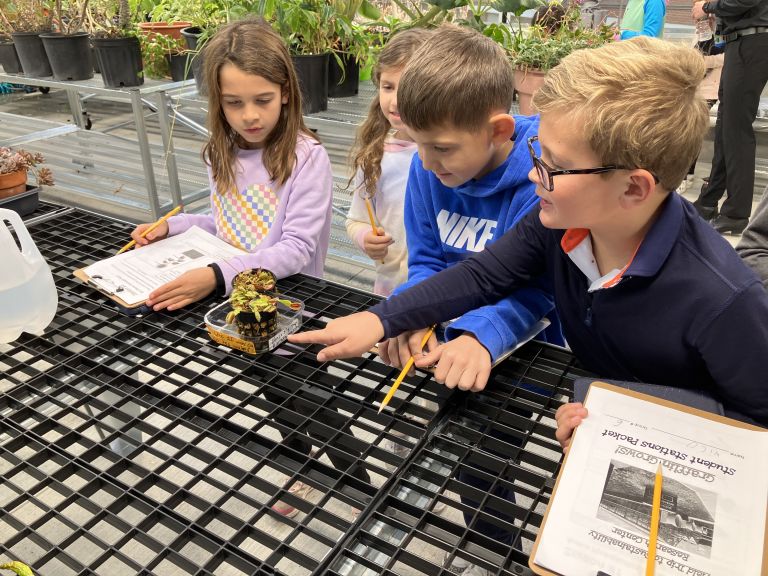Grafflin Grows
Most people think of recycling and composting when envisioning the topic of sustainability: small, relatively sporadic behaviors that one can engage in. But Grafflin Elementary recognizes that sustainability is a key aspect of a healthy lifestyle and not just a one-off behavior, and has been a leader in implementing sustainability principles in the classroom since 1962. The “Grafflin Grows” program is focused on fostering a love of sustainability within young students and building a foundation to continue their sustainability efforts beyond their years in the Chappaqua Central School District.
The program started in 1962 with the construction of the Grafflin atrium by a group of teachers and parents who shared a passion for sustainability and desired a location to teach students basic gardening skills. Seventeen years later, these teachers personally funded and built a greenhouse: Principal Debbie Alspach notes that “the Grafflin Greenhouse was built in 1979 on the passion and hard work of the Grafflin staff, PTA, and parents to teach their children about gardening practices and sustainability. Forty years later, that passion still exists.”
The greenhouse saw no changes until two years ago when it became apparent to Grafflin staff that a curriculum update with more emphasis on sustainability was much needed. Mr. Justin Olive, K-12 Director of Science, says “as of recently, there is an increasing need for sustainability principles to be directly worked into state standards, core curriculum, and instructional practices.” Mr. Olive emphasizes the connection between this curriculum shift and CCSD’s ability to better prepare students for real world success post high school. “This may be considered undergraduate and graduate education, but we want to project even beyond that and look into the needs of the future world!”
Grafflin’s efforts initiating a sustainability program when sustainability was rarely practiced in schools has had a lasting impact on the students who have passed through Grafflin, establishing it as a leader in showcasing and teaching these concepts to a new generation. Current Grafflin student Marlow Poniatowski is one of these influenced students, crediting the Grafflin Grows program with allowing him and his classmates “to discover [their] passion for science and sustainability, and develop strong relationships with [their] classmates and the Grafflin community.”
Part of Mr. Olive’s work as a curriculum developer of CCSD’s K-12 science programming is ensuring continuity throughout a student’s progression in the district. He aims “to focus on the ways that we can build the vertical alignment across the grade levels that allows for our students to continue to build on the prior year’s sustainability education and experiences.”
He is working closely with a team of teachers and administrators to tailor K-12 Sustainability Standards he helped develop to Chappaqua’s personal needs and implement them as soon as possible. Mr. Olive expresses that his current challenge is “continu[ing] to provide access to spaces and opportunities that allow our students to explore them to their fullest potential.” Examples of this include gardening programs at Bell and Seven Bridges, the Farm-To-Table program in middle school family and consumer-science classes, and new sustainability classes offered in the state-of-the-art Greeley Sustainability Center.
Similarly, the Grafflin Grows program is crucial towards providing a basis for student sustainability efforts throughout all of their years in CCSD. “If we begin with some of the larger scale changes at the elementary levels,” Mr. Olive says, “it gives students an opportunity to have an early entry point into the newer versions of curriculum that we can continue to build upon through their future educational career.”
Over the years, each grade at Grafflin has spearheaded an individual project in the greenhouse. Some notable projects include the building of raised beds for the plants by fourth-graders, upcycling using paper towel rolls by second-graders, and planting bulbs and daffodils by first-graders.
At Grafflin, a focus is placed on connecting lessons in the greenhouse to other, more traditional, academic subjects. Fourth-graders plant corn, beans, and squash to supplement their unit on colonialism in Social Studies, replicating the vegetables and legumes Native American tribes in the Chappaqua area would have eaten. Second-graders spend time chronicling their observations on the plants they’ve grown in the greenhouse to enhance their English skills. These interdisciplinary connections continued to expand with the relaunching of the greenhouse curriculum last year in concert with Science 21 integration, which connects social studies, writing, and math to sustainability.
Grafflin continues to grow this program in various ways. Future endeavors include a collaboration with the non-profit greenhouse construction company New York Sun Works, using the leftover grant money from the Greeley Sustainability Center to redesign the Grafflin Greenhouse, as well as a hydroponics program funded by the Chappaqua School Foundation, which underwent initial stages in late January. In addition, cold frames have been installed on the grounds of the greenhouse with the assistance of middle school students in an effort to house, protect, and harden off seedlings and small plants without artificial heat.
Vice Principal Ryan Spillane has another, smaller goal for the greenhouse: the implementation of rain barrels. Rain barrels are key to collecting and recycling rainwater, and could be a valuable resource for Grafflin to not only reduce their water bills but also contribute to their sustainability curriculum. Mr. Spillane suggests that “students can research the average rainfall in the area, and chart how much water they can harvest in one, three, and six months,” as well as “help design and implement irrigation systems off of the rain barrels” with teacher assistance. He personally utilizes two at his home and is considering donating one to Grafflin to start the integration of these barrels into the Grafflin Grows program.
The elementary school has also worked hard to reach out to the community. There have been multiple PTA-sponsored Meet and Greet sessions in the garden, where parents learn directly from their children about their sustainability projects, as well as a tea night and book reading in the greenhouse, the tea infused with Grafflin-grown mint.
With the sustainability education and promotion by Grafflin and its elementary students in our community and beyond, it’s apparent that a greener future is on the horizon.






